Résultats de recherche de titre
Articles 1495841 à 1495860 sur 1496956
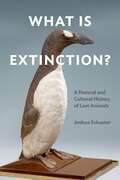
What Is Extinction?: A Natural and Cultural History of Last Animals
Par Joshua Schuster. 2023
WINNER, 25th ANNUAL SUSANNE M. GLASSCOCK BOOK PRIZELife on Earth is facing a mass extinction event of our own making.…
Human activity is changing the biology and the meaning of extinction. What Is Extinction? examines several key moments that have come to define the terms of extinction over the past two centuries, exploring instances of animal and human finitude and the cultural forms used to document and interpret these events.Offering a critical theory for the critically endangered, Joshua Schuster proposes that different discourses of limits and lastness appear in specific extinction events over time as a response to changing attitudes toward species frailty. Understanding these extinction events also involves examining what happens when the conceptual and cultural forms used to account for species finitude are pressed to their limits as well. Schuster provides close readings of several case studies of extinction that bring together environmental humanities and multispecies methods with media-specific analyses at the terminus of life.What Is Extinction? delves into the development of last animal photography, the anthropological and psychoanalytic fascination with human origins and ends, the invention of new literary genres of last fictions, the rise of new extreme biopolitics in the Third Reich that attempted to change the meaning of extinction, and the current pursuit of de-extinction technologies. Schuster offers timely interpretations of how definitions and visions of extinction have changed in the past and continue to change in the present.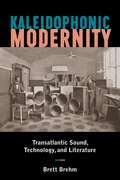
Kaleidophonic Modernity: Transatlantic Sound, Technology, and Literature
Par Brett Brehm. 2023
What stories remain hidden behind one of the most significant inventions of the nineteenth century? Kaleidophonic Modernity reexamines the development…
of mechanical sound recording technology by charting the orbits of writers, scientists, and artists in France and the United States. Working between comparative literature, the history of science, and urban studies, Brehm builds a bridge between visual culture and sound studies.Kaleidophonic Modernity places the poet and inventor Charles Cros and his lover, the celebrated concert pianist and salonnière Nina de Villard at the heart of modern aesthetic and scientific vanguards. Cros's scientific endeavors ranged from color photography, to telecommunications, to mechanical sound reproducibility. In his poetry the Surrealists found an ancestor and inspiration. His literary and scientific works prove startling and relevant to predicaments of technological media in his own time and ours. For nearly twenty years Nina de Villard presided over a supremely daring intellectual salon. There, she welcomed manifold literary, artistic, and musical luminaries into a veritable crucible of the artistic avant-garde and precursor to the famous Chat Noir cabaret. Together, these two forgotten but pivotal figures, Cros and Villard, help reframe our thinking on Edgar Allan Poe, Charles Baudelaire, and Walt Whitman, icons of urban modernity who can now be seen and heard in a kaleidophonic light, one that offers a compelling new perspective on modern mediascapes.In elaborating this transatlantic phenomenon, Kaleidophonic Modernity illuminates the prehistory of the phonograph as it intersects with the aesthetics of sound reproducibility, Franco-American literary exchange, Poe’s aesthetic and intellectual legacy, the sounds of modern cities and technologies, and the genealogy of audiovisual experimentation found in such movements as Dada, Futurism, and the sound art of today.
Fueling Culture: 101 Words for Energy and Environment
Par Jennifer Wenzel, Patricia Yaeger. 2017
How has our relation to energy changed over time? What differences do particular energy sources make to human values, politics,…
and imagination? How have transitions from one energy source to another—from wood to coal, or from oil to solar to whatever comes next—transformed culture and society? What are the implications of uneven access to energy in the past, present, and future? Which concepts and theories clarify our relation to energy, and which just get in the way? Fueling Culture offers a compendium of keywords written by scholars and practitioners from around the world and across the humanities and social sciences. These keywords offer new ways of thinking about energy as both the source and the limit of how we inhabit culture, with the aim of opening up new ways of understanding the seemingly irresolvable contradictions of dependence upon unsustainable energy forms.Fueling Culture brings together writing that is risk-taking and interdisciplinary, drawing on insights from literary and cultural studies, environmental history and ecocriticism, political economy and political ecology, postcolonial and globalization studies, and materialisms old and new.Keywords in this volume include: Aboriginal, Accumulation, Addiction, Affect, America, Animal, Anthropocene, Architecture, Arctic, Automobile, Boom, Canada, Catastrophe, Change, Charcoal, China, Coal, Community, Corporation, Crisis, Dams, Demand, Detritus, Disaster, Ecology, Electricity, Embodiment, Ethics, Evolution, Exhaust, Fallout, Fiction, Fracking, Future, Gender, Green, Grids, Guilt, Identity, Image, Infrastructure, Innervation, Kerosene, Lebenskraft, Limits, Media, Metabolism, Middle East, Nature, Necessity, Networks, Nigeria, Nuclear, Petroviolence, Photography, Pipelines, Plastics, Renewable, Resilience, Risk, Roads, Rubber, Rural, Russia, Servers, Shame, Solar, Spill, Spiritual, Statistics, Surveillance, Sustainability, Tallow, Texas, Textiles, Utopia, Venezuela, Whaling, Wood, Work For a full list of keywords in and contributors to this volume, please go to: http://ow.ly/4mZZxV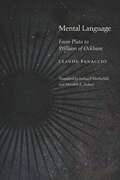
Mental Language: From Plato to William of Ockham (Medieval Philosophy: Texts and Studies)
Par Claude Panaccio. 2017
The notion that human thought is structured like a language, with a precise syntax and semantics, has been pivotal in…
recent philosophy of mind. Yet it is not a new idea: it was systematically explored in the fourteenth century by William of Ockham and became central in late medieval philosophy. Mental Language examines the background of Ockham's innovation by tracing the history of the mental language theme in ancient and medieval thought.Panaccio identifies two important traditions: one philosophical, stemming from Plato and Aristotle, and the other theological, rooted in the Fathers of the Christian Church. The study then focuses on the merging of the two traditions in the Middle Ages, as they gave rise to detailed discussions over the structure of human thought and its relations with signs and language. Ultimately, Panaccio stresses the originality and significance of Ockham's doctrine of the oratio mentalis (mental discourse) and the strong impression it made upon his immediate successors.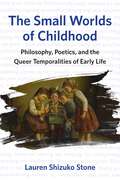
The Small Worlds of Childhood: Philosophy, Poetics, and the Queer Temporalities of Early Life
Par Lauren Shizuko Stone. 2025
The Small Worlds of Childhood argues that prose representations of bourgeois childhood contain surprising opportunities to reflect on the temporality…
of experience. In their narratives of children at home in their everyday worlds, Adalbert Stifter, Rainer Maria Rilke, and Walter Benjamin are not only able to shed a unique light on key issues in the history of philosophy. They also offer a queer critique of the normative expectation that the literature of childhood is oriented toward the future. Stone shows that when writers engage in philosophical storytelling, showing children tarrying in quotidian experience, they dislodge childhood from its nostalgic value to grown-ups and the heteronormative demand to grow up. Such stories of children as philosophical subjects thus take on their own lingering, backwards, or all together strange sense of time. Stone demonstrates the necessity of recognizing how texts on childhood—before and beyond Freud—engage literary language in the service of a variety of philosophical attitudes, reminding us how poetic techniques can tell us something extraordinary about moments of ordinary experience and the manner with which humans, and especially children, cognize the world. By bringing canonical German-language literary and philosophical traditions into conversation with current English-language queer approaches, Stone opens a queer counter-history of German and Austrian realist and modernist literature. This title is available from the publisher on an open-access basis.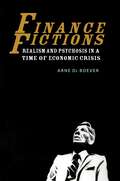
Finance Fictions: Realism and Psychosis in a Time of Economic Crisis
Par Arne De Boever. 2018
Finance Fictions takes the measure of what it means to live in a world ruled by high finance by examining…
the tension between psychosis and realism that plays out in the contemporary finance novel. When the things traded at the center of the economy cease to be things at all, but highly abstracted speculations, how do we come to see the real? What sorts of narrative can accurately approach the actual workings of a neoliberal economy marked by accelerating cycles of market crashes, economic and political crisis, and austerity?Revisiting such twentieth-century classics of the genre as Tom Wolfe's Bonfire of the Vanities and Bret Easton Ellis’s American Psycho, De Boever argues that the twenty-first century is witnessing the birth of a new kind of realistic novel that can make sense of complex financial instruments like collateralized debt obligations, credit default swaps, and digital algorithms operating at speeds faster than what human beings or computers can record. If in 1989 Wolfe could still urge novelists to work harder to “tame the billion-footed beast of reality,” today’s economic reality confronts us with a difference that is qualitative rather than quantitative: a new financial ontology requiring new modes of thinking and writing.Mobilizing the philosophical thought of Quentin Meillassoux in the close reading of finance novels by Robert Harris, Michel Houellebecq, Ben Lerner and less well-known works of conceptual writing such as Mathew Timmons’ Credit, Finance Fictions argues that realism is in for a speculative update if it wants to take on the contemporary economy—an “if” whose implications turn out to be deeply political. Part literary study and part philosophical inquiry, Finance Fictions seeks to contribute to a new mindset for creative and critical work on finance in the twenty-first century.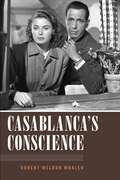
Casablanca's Conscience
Par Robert Weldon Whalen. 2024
A new look at a beloved classic film that explores the philosophical dynamics of CasablancaCelebrating its eightieth anniversary this year,…
Casablanca remains one of the world’s most enduringly favorite movies. It won three Academy Awards for Best Picture, Best Director, and Best Adapted Screenplay. It is still commonly quoted: “We’ll always have Paris” and “Here’s looking at you, kid” And who can forget, “You must remember this…a kiss is just a kiss.” Yet no one expected much to come of this little film, certainly not its blockbuster stars or even the studio producing it. So how did this hastily cranked-out 1940s film, despite its many limitations, become one of the greatest films ever made? How is it that year after year, decade after decade, it continues to appear in the lists of the greatest movies ever produced? And why do audiences still weep when Rick and Ilsa part? The answer, according to Casablanca’s Conscience, is to paraphrase Rick, “It’s true.”Much has already been written about the film and the career-defining performances of Bogart and Bergman. Casablanca is an epic tale of love, betrayal, and sacrifice set against the backdrop of World War II. Yet decades later, it continues to capture the imagination of filmgoers. In Casablanca’s Conscience, author Robert Weldon Whalen explains why it still resonates so deeply. Applying a new lens to an old classic, Whalen focuses on the film’s timeless themes—Exile, Purgatory, Irony, Love, Resistance, and Memory. He then engages the fictional characters—Rick, Ilsa, and the others—against the philosophical and theological discourse of their real contemporaries, Hannah Arendt, Dietrich Bonhoeffer, and Albert Camus. The relationships between fictional and historical persons illuminate both the film’s era as well as perennial human concerns. Both the film and the work of the philosophers explore dimensions of the human experience, which, while extreme, are familiar to everyone. It’s the themes that resonate with the viewer, that have sustained it as an evergreen classic all these years.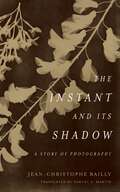
The Instant and Its Shadow: A Story of Photography
Par Jean-Christophe Bailly. 2020
A compelling and innovative reflection on the way photography captures and condenses timeTwo photographs, connected by a ladder, separated by…
a century. First, William Henry Fox Talbot photographed a faithfully realistic image of a ladder against a haystack in the English countryside.One hundred years later, an anonymous photographer captured another ladder, “photographed” alongside an incinerated man by the blinding light of the atomic bomb. These two images underpin a poetic and theoretical reflection on the origins of photographic technique, the imaginative power of montage, and the relation of photography to time itself in Jean-Christophe Bailly’s The Instant and Its Shadow, translated into English for the very first time.A rare find of intellectual caliber and theoretical rigor, The Instant and Its Shadow pursues a unique and powerful reflection on the first hundred years of photography’s history and on the essence of the photographic art in general. Inspired by the unexpected coming together of these two iconic images, the book begins by retracing Talbot’s invention of the photographic calotype in the early nineteenthcentury, highlighting the paradox that saw Talbot wishing to imitate the representative arts of painting and drawing while simultaneously liberating the image from any imitative paradigm. This analysis leads Bailly to elucidate photography’s relation to material and visual reality. A meditation on photography’s seeming ability to stop time follows, concluding with the photographs of Hiroshima and the photographic nature of the atomic bomb. Building on an inspired juxtaposition of The Haystack with the Hiroshima photographs, the book becomes a testament to the potency of photomontage, arguing that “the more singular an image, the greater its connective power.” Bailly’s book is at once a lyrical homage to some of the founding texts of photographic theory and a startling reminder of the uncanny power of photography itself. Part theoretical reflection, part lyrical reverie, The Instant and Its Shadow is packed with profound and stellar insights about the medium.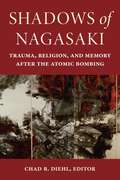
A critical introduction to how the Nagasaki atomic bombing has been remembered, especially in contrast to that of Hiroshima.In the…
decades following the atomic bombing of Nagasaki on August 9, 1945, the city’s residents processed their trauma and formed narratives of the destruction and reconstruction in ways that reflected their regional history and social makeup. In doing so, they created a multi-layered urban identity as an atomic-bombed city that differed markedly from Hiroshima’s image. Shadows of Nagasaki traces how Nagasaki’s trauma, history, and memory of the bombing manifested through some of the city’s many post-atomic memoryscapes, such as literature, religious discourse, art, historical landmarks, commemorative spaces, and architecture. In addition, the book pays particular attention to how the city’s history of international culture, exemplified best perhaps by the region’s Christian (especially Catholic) past, informed its response to the atomic trauma and shaped its postwar urban identity. Key historical actors in the volume’s chapters include writers, Japanese- Catholic leaders, atomic-bombing survivors (known as hibakusha), municipal officials, American occupation personnel, peace activists, artists, and architects. The story of how these diverse groups of people processed and participated in the discourse surrounding the legacies of Nagasaki’s bombing shows how regional history, culture, and politics—rather than national ones—become the most influential factors shaping narratives of destruction and reconstruction after mass trauma. In turn, and especially in the case of urban destruction, new identities emerge and old ones are rekindled, not to serve national politics or social interests but to bolster narratives that reflect local circumstances.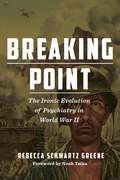
Breaking Point: The Ironic Evolution of Psychiatry in World War II (World War II: The Global, Human, and Ethical Dimension)
Par Rebecca Schwartz Greene. 2023
WINNER, SOCIETY FOR MILITARY HISTORY DISTINGUISHED BOOK AWARDS - FIRST BOOKThis book informs the public for the first time about…
the impact of American psychiatry on soldiers during World War II.Breaking Point is the first in-depth history of American psychiatry in World War II. Drawn from unpublished primary documents, oral histories, and the author’s personal interviews and correspondence over years with key psychiatric and military policymakers, it begins with Franklin Roosevelt’s endorsement of a universal Selective Service psychiatric examination followed by Army and Navy pre- and post-induction examinations. Ultimately, 2.5 million men and women were rejected or discharged from military service on neuropsychiatric grounds. Never before or since has the United States engaged in such a program.In designing Selective Service Medical Circular No. 1, psychiatrist Harry Stack Sullivan assumed psychiatrists could predict who might break down or falter in military service or even in civilian life thereafter. While many American and European psychiatrists questioned this belief, and huge numbers of American psychiatric casualties soon raised questions about screening’s validity, psychiatric and military leaders persisted in 1942 and 1943 in endorsing ever tougher screening and little else. Soon, families complained of fathers and teens being drafted instead of being identified as psychiatric 4Fs, and Blacks and Native Americans, among others, complained of bias. A frustrated General George S. Patton famously slapped two “malingering” neuropsychiatric patients in Sicily (a sentiment shared by Marshall and Eisenhower, though they favored a tamer style). Yet psychiatric rejections, evacuations, and discharges mounted.While psychiatrist Roy Grinker and a few others treated soldiers close to the front in Tunisia in early 1943, this was the exception. But as demand for manpower soared and psychiatrists finally went to the field and saw that combat itself, not “predisposition,” precipitated breakdown, leading military psychiatrists switched their emphasis from screening to prevention and treatment. But this switch was too little too late and slowed by a year-long series of Inspector General investigations even while numbers of psychiatric casualties soared. Ironically, despite and even partly because of psychiatrists’ wartime performance, plus the emotional toll of war, postwar America soon witnessed a dramatic growth in numbers, popularity, and influence of the profession, culminating in the National Mental Health Act (1946). But veterans with “PTSD,” not recognized until 1980, were largely neglected.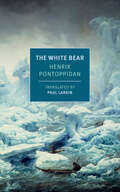
The White Bear
Par Henrik Pontoppidan. 2025
Love, faith, and the political mingle in these two short novels by a Nobel Prize-winning Danish author. One about a…
young couple making a new life in Rome, the other about a priest who goes to live among native peoples in Greenland, both books explore the reaches of the human heart through their complex and unforgettable characters.Henrik Pontoppidan, the Danish Nobel laureate, is admired for the concentrated force of his novellas as much as for long, populous, world-encompassing novels like A Fortunate Man, and here are two of those novellas, newly and brilliantly translated by Paul Larkin.The White Bear follows the fate of the odd, gangly, red-bearded Thorkild Müller. Born in rural Jutland and destined for the ministry, Thorkild proves to be a poor student and is assigned to a remote Inuit tribe in Greenland. There, with his mythic-looking staff and dogskin skullcap, he becomes known as the White Bear—a beloved legend among the locals and a freewheeling embarrassment to his fellow priests. Grown old, he returns to Denmark, where again his flock adores him while his fellow men of cloth try to tame the "whirling dervish in their midst." In the end Thorkild mysteriously disappears, presumably back to the snow wilderness of Greenland.The Rearguard, on the other hand, is a marriage story. Newlyweds Jørgen Hallager and Ursula Branth are as different as night and day. The brash son of a poor village teacher, Jørgen is an avowed socialist whose revolutionary beliefs translate into his work as a painter of social realism; Ursula comes from a conservative, upper-middle-class family. At first, as they start their married life in Rome, they each try to change the other's worldview with arguments and threats, but as time wears on and they wear each other down, it becomes clear there can be no reconciliation. It is a tragic tale of art and idealism, individuality and love.This translation was funded in part by a grant from the Danish Arts Foundation.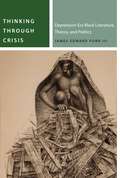
Thinking Through Crisis: Depression-Era Black Literature, Theory, and Politics (Commonalities)
Par James Edward Ford III. 2020
Winner, 2020 William Sanders Scarborough Prize, Modern Language AssociationHonorable Mention, MSA First Book PrizeIn Thinking Through Crisis, James Edward Ford…
III examines the works of Richard Wright, Ida B. Wells, W. E. B. Du Bois, Zora Neale Hurston, and Langston Hughes during the 1930s in order to articulate a materialist theory of trauma. Ford highlights the dark proletariat’s emergence from the multitude apposite to white supremacist agendas. In these works, Ford argues, proletarian, modernist, and surrealist aesthetics transform fugitive slaves, sharecroppers, leased convicts, levee workers, and activist intellectuals into protagonists of anti-racist and anti-capitalist movements in the United States.Thinking Through Crisis intervenes in debates on the 1930s, radical subjectivity, and states of emergency. It will be of interest to scholars of American literature, African American literature, proletarian literature, black studies, trauma theory, and political theory.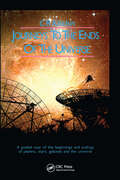
Journeys to the Ends of the Universe presents a tour through the universe from the big bang onward. The book…
explores the limits of knowledge where scientific fact overtakes and merges with the wilder speculations of science fiction. The beginnings of galaxies, stars, planets, and even life itself are related back to the raveled turmoil of the first few seconds and years of life in the cosmos. The journey continues past the ultimate fate of the solar system to probe the nature of supernovae. The future of galaxies, clusters of galaxies, super-clusters of clusters of galaxies, and so on leads toward the finale, where the author provides some bizarre musings of physicists and astronomers, suggesting possible destinies for the universe stretching its present age billions of times into the future.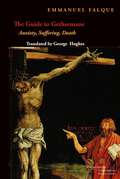
The Guide to Gethsemane: Anxiety, Suffering, Death (Perspectives in Continental Philosophy)
Par Emmanuel Falque. 2019
Anxiety, suffering and death are not simply the “ills” of our society, nor are they uniquely the product of a…
sick and sinful humanity. We must all some day confront them, and we continually face their implications long before we do. In that sense, the Garden of Gethsemane is not merely a garden “outside the walls” of Jerusalem but also the essential horizon for all of us, whether we are believers or not.Emmanuel Falque explores, with no small measure of doubt, Heidegger’s famous statement that by virtue of Christianity’s claims of salvation and the afterlife, its believers cannot authentically experience anxiety in the face of death. In this theological development of the Passion, already widely debated upon its publication in French, Falque places a radical emphasis on the physicality and corporeality of Christ’s suffering and death, marking the continuities between Christ’s Passion and our own orientation to the mortality of our bodies. Beginning with an elaborate reading of the divine and human bodies whose suffering is masterfully depicted in the Isenheim Altarpiece, and written in the wake of the death of a close friend, Falques’s study is both theologically rigorous and marked by deeply human concerns.Falque is at unusual pains to elaborate the question of death in terms not merely of faith, but of a “credible Christianity” that remains meaningful to non-Christians, holding, with Maurice Blondel, that “the important thing is not to address believers but to say something which counts in the eyes of unbelievers.” His account is therefore as much a work of philosophy as of theology—and of philosophy explicated not through abstractions but through familiar and ordinary experience. Theology’s task, for Falque, is to understand that human problems of the meaning of existence apply even to Christ, at least insofar as he lives in and shares our finitude. In Falque’s remarkable account, Christ takes upon himself the burden of suffering finitude, so that he can undertake a passage through it, or a transformation of it.This book, a key text from one the most remarkable of a younger generation of philosophers and theologians, will be widely read and debated by all who hold that theology and philosophy has the most to offer when it eschews easy answers and takes seriously our most anguishing human experiences.
The Planet Earth and The Universe (Planet Guides)
Par Duncan Brewer. 1992
This short yet informative book discusses the Big Bang Theory, and how the planets were formed, as well as the…
debates of ancient astronomers whether the earth was the center of the Universe or if the sun was. Informative facts about the Earth as a planet, and interesting facts about its moon. Worth reading if interested in fundamental astronomy or the planets. Great for all ages. Scientific terms are defined in the text and in a glossary. Picture captions give meat to the story.
Education at War: The Fight for Students of Color in America's Public Schools
Par Arshad Imtiaz Ali and Tracy Lachica Buenavista. 2018
Education at War: The Fight for Students of Color in America's Public Schools, attempts to shape educational research and practice…
to more explicitly consider the relationship between education, capitalism and war, and more specifically, its’ impact on students of color. The authors, as a whole, contend that the contemporary specter of war has become a central way that racism and materialism become manifested and practiced within education. In particular, this collection asserts that the contemporary neoliberal characterization of education and school-based reform is situated within the global political economy that has facilitated a growth in the prison and military industrial complex, and simultaneous divestment in education domestically within the U.S.Education at War attempts to make research relevant by bringing the tensions within young people’s lives to the fore. The heavy shadow cast by recent U.S. led wars re-organizes the sites of learning and teaching nationally, as well as differentially, within specific sites and upon particular communities. Nonetheless, the examination of this context is not enough. Rather, we consider how such a contemporary context can facilitate educational spaces for communities and youth to grow their vision for a different, and hopefully a more humanizing future. Thus, the book contributors will collectively explore how resistance can produce the opportunity for rich, diverse and transformative learning for marginalized students and communities.The lives of People of Color are the forefront of Education at War: The Fight for Students of Color in America's Public Schools. Whereas there are many attempts to theorize about the global implications of war, less attention is paid to the ways that war shapes young lives in the U.S., particularly in an educational context. The book addresses the absence of youth-centered discussions regarding education during a political context of neoliberalism and war, and provides important perspectives on which to ground critical discussions among students and families, education scholars and practitioners, and policymakers.
Tempus: The World of Discussion and the World of Narration (Verbal Arts: Studies in Poetics)
Par Harald Weinrich. 2023
A foundational book by one of the most distinguished German humanists of the last half century, Tempus joins cultural linguistics…
and literary interpretation at the hip. Developing two controversial theses—that sentences are not truly meaningful in isolation from their contexts and that verb tenses are primarily indicators not of time but of the attitude of the speaker or writer—Tempus surveys a dazzling array of ancient and modern texts from famous authors as well as casual speakers of German, French, Italian, Spanish, Portuguese, Latin, and English, with a final chapter extending the observations to Greek, Russian, and world languages.A classic in German and long available in many other languages, Tempus launched a new discipline, text linguistics, and established a unique career that was marked by precise observation, sensitive cultural outreach, and practical engagement with the situation of migrants. Weinrich’s robust and lucid close readings of famous and little-known authors from all the major languages of western Europe expand our literary horizons and challenge our linguistic understanding.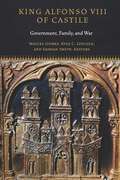
King Alfonso VIII of Castile: Government, Family, and War (Fordham Series in Medieval Studies)
Par Miguel Gómez, Damian Smith, and Kyle C. Lincoln. 2019
King Alfonso VIII of Castile: Government, Family and War brings together a diverse group of scholars whose work concerns the…
reign of Alfonso VIII (1158–1215). This was a critical period in the history of the Iberian peninsula, when the conflict between the Christian north and the Moroccan empire of the Almohads was at its most intense, while the political divisions between the five Christian kingdoms reached their high-water mark. From his troubled ascension as a child to his victory at Las Navas de Tolosa near the end of his fifty-seven-year reign, Alfonso VIII and his kingdom were at the epicenter of many of the most dramatic events of the era.Contributors: Martin Alvira Cabrer, Janna Bianchini, Sam Zeno Conedera, S.J., Miguel Dolan Gómez, Carlos de Ayala Martínez, Kyle C. Lincoln, Joseph O’Callaghan, Teofi lo F. Ruiz, Miriam Shadis, Damian J. Smith, James J. Todesca
The Mark of Theory: Inscriptive Figures, Poststructuralist Prehistories
Par Andrea Bachner. 2018
What imaginaries, tropes, and media have shaped how we theorize? The Mark of Theory argues that inscription constitutes one of…
the master metaphors of contemporary theory.As a trope that draws on a wide array of practices of marking, from tattooing to circumcision, from photographic imprints and phonographic grooves to marks on a page, inscription provides an imaginary that orients and irritates theoretical thought. Tracing inscriptive imaginaries from the late nineteenth century to today, The Mark of Theory offers a wide-ranging conceptual genealogy of contemporary thought. Navigating poststructuralism’s attention to figurative language as well as media theory’s attention to objects, phenomena, and practices of mediation, the book works through core questions for how we theorize. Across a range of disciplines and scholarly conversations—from literature and media to anthropology, race and gender, art, psychoanalysis, sound, and ultimately ethics—sites of inscription come to constitute the past legacy of a thought to come, a prehistory of our current moment.In focusing on materiality and mediation The Mark of Theory shows how inscriptive practices shape conceptual thought, as well as political and ethical choices. By contextualizing the fraught relationship between materiality and signification, The Mark of Theory lays the ground for a politics of theory that begins there where theory and politics are no longer conflated.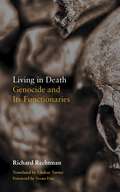
Living in Death: Genocide and Its Functionaries (Thinking from Elsewhere)
Par Richard Rechtman. 2020
Winner, Prix Littéraire Paris-Liège 2021 Winner, French Voices Award for Excellence in Publication and TranslationWhen we speak of mass killers,…
we may speak of radicalized ideologues, mediocrities who only obey orders, or bloodthirsty monsters. Who are these men who kill on a mass scale? What is their consciousness? Do they not feel horror or compassion?Richard Rechtman’s Living in Death offers new answers to a question that has haunted us at least since the Holocaust. For Rechtman, it is not ideologies that kill, but people. This book descends into the ordinary life of people who execute hundreds every day, the same way others go to the office. Bringing philosophical sophistication to the ordinary, the book constitutes an anthropology of mass killers.Turning away from existing psychological and philosophical accounts of genocide’s perpetrators, Rechtman instead explores the conditions under which administering death becomes a job like any other. Considering Cambodia, Rwanda, and other mass killings, Living in Death draws on a vast array of archival research, psychological theory, and anecdotes from the author’s clinical work with refugees and former participants in genocide. Rechtman mounts a compelling case for reframing and refocusing our attempts to explain—and preempt—acts of mass torture, rape, killing, and extermination.What we must see, Rechtman argues, is that for genocidaires (those who carry out acts that are or approach genocide), there is nothing extraordinary, unusual, or world-historical about their actions. On the contrary, they are preoccupied with the same mundane things that characterize any other job: interactions with colleagues, living conditions, a drink and a laugh at the end of the day. To understand this is to understand how things came to be the way they are—and how they might be different.